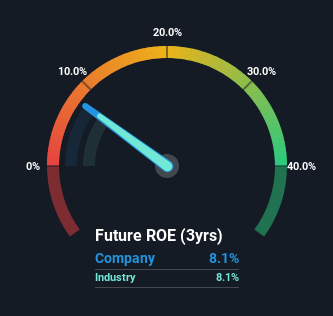Does Essential Utilities, Inc. (NYSE:WTRG) Create Value For Shareholders?
Does Essential Utilities, Inc. (NYSE:WTRG) Create Value For Shareholders?
Many investors are still learning about the various metrics that can be useful when analysing a stock. This article is for those who would like to learn about Return On Equity (ROE). By way of learning-by-doing, we'll look at ROE to gain a better understanding of Essential Utilities, Inc. (NYSE:WTRG).
許多投資者仍在學習分析股票時可能有用的各種指標。本文適用於那些想了解股本回報率(ROE)的人。通過邊幹邊學的方式,我們將研究投資回報率,以更好地了解基本公用事業公司(紐約證券交易所代碼:WTRG)。
ROE or return on equity is a useful tool to assess how effectively a company can generate returns on the investment it received from its shareholders. In other words, it is a profitability ratio which measures the rate of return on the capital provided by the company's shareholders.
投資回報率或股本回報率是評估公司如何有效地從股東那裏獲得投資回報的有用工具。換句話說,它是衡量公司股東提供的資本回報率的盈利比率。
Check out our latest analysis for Essential Utilities
查看我們對基本實用程序的最新分析
How Is ROE Calculated?
ROE 是如何計算的?
The formula for return on equity is:
股本回報率的公式是:
Return on Equity = Net Profit (from continuing operations) ÷ Shareholders' Equity
股本回報率 = 淨利潤(來自持續經營業務)÷ 股東權益
So, based on the above formula, the ROE for Essential Utilities is:
因此,根據上述公式,基本公用事業的投資回報率爲:
8.1% = US$478m ÷ US$5.9b (Based on the trailing twelve months to September 2023).
8.1% = 4.78億美元 ÷ 59億美元(基於截至2023年9月的過去十二個月)。
The 'return' is the amount earned after tax over the last twelve months. One way to conceptualize this is that for each $1 of shareholders' capital it has, the company made $0.08 in profit.
“回報” 是過去十二個月的稅後收入。將其概念化的一種方法是,公司每擁有1美元的股東資本,就會獲得0.08美元的利潤。
Does Essential Utilities Have A Good Return On Equity?
基本公用事業有不錯的股本回報率嗎?
By comparing a company's ROE with its industry average, we can get a quick measure of how good it is. The limitation of this approach is that some companies are quite different from others, even within the same industry classification. You can see in the graphic below that Essential Utilities has an ROE that is fairly close to the average for the Water Utilities industry (8.1%).
通過將公司的投資回報率與其行業平均水平進行比較,我們可以快速衡量其表現如何。這種方法的侷限性在於,有些公司與其他公司有很大不同,即使在相同的行業分類中也是如此。你可以在下圖中看到,基本公用事業的投資回報率與水務行業的平均水平(8.1%)相當接近。

So while the ROE is not exceptional, at least its acceptable. While at least the ROE is not lower than the industry, its still worth checking what role the company's debt plays as high debt levels relative to equity may also make the ROE appear high. If so, this increases its exposure to financial risk. Our risks dashboardshould have the 3 risks we have identified for Essential Utilities.
因此,儘管投資回報率並不例外,但至少是可以接受的。儘管至少投資回報率不低於該行業,但仍值得檢查該公司的債務起了什麼作用,因爲相對於股權的高債務水平也可能使投資回報率顯得很高。如果是這樣,這會增加其金融風險敞口。我們的風險儀表板應包含我們爲基本公用事業確定的三種風險。
How Does Debt Impact ROE?
債務如何影響投資回報率?
Companies usually need to invest money to grow their profits. The cash for investment can come from prior year profits (retained earnings), issuing new shares, or borrowing. In the case of the first and second options, the ROE will reflect this use of cash, for growth. In the latter case, the debt required for growth will boost returns, but will not impact the shareholders' equity. In this manner the use of debt will boost ROE, even though the core economics of the business stay the same.
公司通常需要投資來增加利潤。投資現金可以來自上一年的利潤(留存收益)、發行新股或借款。對於第一和第二種選擇,投資回報率將反映這種對現金增長的使用。在後一種情況下,增長所需的債務將提高回報,但不會影響股東權益。通過這種方式,儘管企業的核心經濟保持不變,但債務的使用將提高投資回報率。
Essential Utilities' Debt And Its 8.1% ROE
基本公用事業的債務及其8.1%的投資回報率
It's worth noting the high use of debt by Essential Utilities, leading to its debt to equity ratio of 1.15. The combination of a rather low ROE and significant use of debt is not particularly appealing. Debt increases risk and reduces options for the company in the future, so you generally want to see some good returns from using it.
值得注意的是,基本公用事業公司大量使用債務,導致其負債權益比率爲1.15。相當低的投資回報率和大量使用債務相結合並不是特別有吸引力。債務會增加風險,減少公司未來的選擇,因此您通常希望從使用債務中獲得豐厚的回報。
Conclusion
結論
Return on equity is a useful indicator of the ability of a business to generate profits and return them to shareholders. Companies that can achieve high returns on equity without too much debt are generally of good quality. If two companies have around the same level of debt to equity, and one has a higher ROE, I'd generally prefer the one with higher ROE.
股本回報率是衡量企業創造利潤並將其返還給股東的能力的有用指標。能夠在不負債過多的情況下獲得高股本回報的公司通常質量很好。如果兩家公司的債務與股權比率大致相同,而一家公司的投資回報率更高,那麼我通常更喜歡投資回報率更高的那家公司。
But ROE is just one piece of a bigger puzzle, since high quality businesses often trade on high multiples of earnings. The rate at which profits are likely to grow, relative to the expectations of profit growth reflected in the current price, must be considered, too. So you might want to take a peek at this data-rich interactive graph of forecasts for the company.
但是投資回報率只是更大難題中的一部分,因爲高質量的企業通常以高倍的收益進行交易。還必須考慮利潤可能增長的速度,相對於當前價格所反映的利潤增長預期。因此,你可能想看看這張數據豐富的公司預測交互式圖表。
But note: Essential Utilities may not be the best stock to buy. So take a peek at this free list of interesting companies with high ROE and low debt.
但請注意:基本公用事業可能不是最值得購買的股票。因此,來看看這份投資回報率高、債務低的有趣公司的免費清單。
Have feedback on this article? Concerned about the content? Get in touch with us directly. Alternatively, email editorial-team (at) simplywallst.com.
This article by Simply Wall St is general in nature. We provide commentary based on historical data and analyst forecasts only using an unbiased methodology and our articles are not intended to be financial advice. It does not constitute a recommendation to buy or sell any stock, and does not take account of your objectives, or your financial situation. We aim to bring you long-term focused analysis driven by fundamental data. Note that our analysis may not factor in the latest price-sensitive company announcements or qualitative material. Simply Wall St has no position in any stocks mentioned.
對這篇文章有反饋嗎?對內容感到擔憂?直接聯繫我們。 或者,給編輯團隊 (at) simplywallst.com 發送電子郵件。
Simply Wall St的這篇文章本質上是籠統的。我們僅使用公正的方法根據歷史數據和分析師的預測提供評論,我們的文章無意作爲財務建議。它不構成買入或賣出任何股票的建議,也沒有考慮到您的目標或財務狀況。我們的目標是爲您提供由基本數據驅動的長期重點分析。請注意,我們的分析可能不考慮最新的價格敏感型公司公告或定性材料。簡而言之,華爾街沒有持有任何上述股票的頭寸。

 The formula for return on equity is:
The formula for return on equity is: